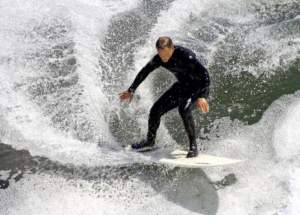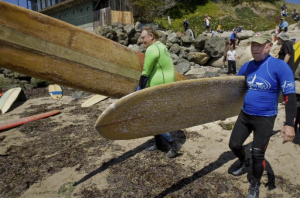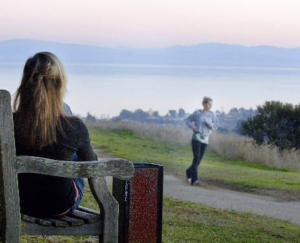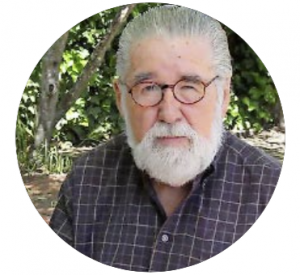Companies
La Ola Tecnologica de Santa Cruz

By Andrea Muñoz H. (Andrea Muñoz Hinrichsen)
El Mercurio
Translation by Claudia Melendez
September 17, 2015 — Santa Cruz, CA (and Santiago, Chile)
Santa Cruz Technology Wave — a story about the identity conflict of a beach town in the midst of transition.
[Editor’s note: This article was published in its original form on September 13, 2015, in El Mercurio, a leading Chilean newspaper and the oldest in Latin America. Founded in 1827, El Mercurio has a circulation of 112,000 weekly and 345,000 on Sundays. View PDF.]

Ocean view: Almost a third of Santa Cruz residents drive to work to Silicon Valley every day. With a population of 62,000, Santa Cruz combines its retro lifestyle with modern influences from Palo Alto and San José. (Credit: Wikimedia Commons)
Santa Cruz began its transformation into a surfing destination 130 years ago, when three Hawaiian princes rode their boards down the San Lorenzo River. But in the last few years, Santa Cruz has been riding a technology wave that originates from neighboring Silicon Valley. Here’s a story about the identity conflict of a beach town in the midst of transition.
The story will change depending on the route you choose to get to Santa Cruz. If you leave from San Francisco, one of the options is to take Highway 1, a two-lane road that’s slow and always overlooking the ocean. That’s why it’s the perfect introduction to the town that appears after an almost two-hour drive to the north of the Monterey Peninsula, where there are a bit more than 60,000 people and schedules adjust to fit the water’s movement.
I think about this on a Friday in August at 11 a.m. when I can’t find the person I was planning to meet. He was supposed to be waiting for me in his office, but took off suddenly to surf, as he later confessed. I had already been warned by a self-taught surf meteorologist, Mark Sponsler, who specializes in predicting big waves, who said, “This is not like golf, where you can schedule to be out at 6 a.m. In this game, there may be no course at 6 a.m.”
There was a course today. After waiting for 40 minutes, I head to Pleasure Point, one of the most famous surfing areas in town. At this time, the waves reach the neck of the surfers who manage to ride their boards. There’s dozens taking advantage of the conditions, all wearing dark suits and looking toward the same point on the horizon. They’re like black Sphinxes trying to solve puzzles in the water.

Landmark: Pleasure Point is a famous area in Santa Cruz. It’s located in front of the home of Jack O’Neill, the first one to sell neoprene wetsuits. (Credit: El Mercurio)
A guy who could be 20, 30 or 40 comes near me. Nice glasses. Like John Lennon’s.
It’s the corner of 33rd and East Cliff Drive, a few feet from the ocean, and we’re the only ones wearing cotton instead of neoprene. I ask him if he’s from here, and he says he’s from here and there and everywhere, that he sleeps in a car. And yes, it is always the same here, every time there’s waves. It’s a local tradition to surf towards that house, he says, pointing toward a greenish wooden building at the edge of a cliff.
“Why to that house?” I ask.
“Because that’s Jack’s house,” he replies.
Jack is Jack O’Neill, of the neoprene wetsuits — he was the first to sell them commercially at the beginning of the 1950s. It’s understandable that he was inspired here: during the winter, the water’s temperature is about 40 degrees.
The man tells me he used to see O’Neill early in the morning, walking along from his house to the lookout where we stand, sporting his white hair and his eye patch (I later read that O’Neill lost his left eye more than forty years ago, surfing on another beach a few miles from here). But Jack has aged and hardly comes out anymore.
“A pity,” the man tells me. “He was good at making conversation.”

Historical: The Beach Boardwalk near the wharf in Santa Cruz is one of the oldest in California, built in 1907. (Credit: El Mercurio)
Another way to arrive to Santa Cruz is through Highway 17, a winding road through mountains dotted with ancient redwoods, high as bell towers. But unlike the coastal road, here it’s the view or your life: the curves are mercurial, the speed is high and the accidents come frequently. It’s not a long road — only about 35 miles separate Santa Cruz from San José, the self-proclaimed capital of Silicon Valley. But the narrowness of its curves is a psychological barrier between the beach town and the world of Google, Apple and Intel. In Santa Cruz, to take this road is to go “over the hill.”
Maybe that’s why the Santa Cruzan personality is so different from that of its close neighbors.
There are no golf courses as there are in Monterey. In Santa Cruz there’s a pirate’s ship, bars where you can smoke cigars and public benches – these have almost disappeared from wealthier cities for fear of attracting, with a place to sit down, those who have little.
Still, in spite of its beach town atmosphere, close to 18,000 Santa Cruzans travel Highway 17 every day to reach their jobs in Silicon Valley. It’s almost a third of the town.
“There’s a lot of people who choose to live in Santa Cruz because of the lifestyle it offers. But they spend a lot of hours in their cars to get to their jobs,” says Toby Corey, co-founder of Tuul, a startup that launched in Santa Cruz a bit more than a year ago.
We’re having lunch in a restaurant a few steps from his office, in the heart of downtown. The office is right next to a pawn shop – not exactly a street with a corporate look. But this company has just raised $4 million in startup funds and plans to hire 100 people in the next 12 months.
Corey could have launched his company in San Francisco, Mountain View or Palo Alto. But he and Tuul co-founder Wayne Tsuchitani opted to set up here, he explains as we eat, precisely to try to attract the floating population that commutes daily over the hill.
It makes sense. In Silicon Valley, the competition to hire personnel has unleashed an arms race of sorts when it comes to offering benefits. A company has started to offer sushi during lunch. In short order, the rest start making room for volleyball courts and special rooms for employees to take naps. But there’s no need to offer perks in Santa Cruz; those come with the territory. From this office, it would take you less than 15 minutes to walk to the roller coaster on the beach.
“We offer bottled water,” Tsuchitani tells me. “And that was a fight.”
He went to live in Santa Cruz 30 years ago, and he also worked over the hill for a long time. When it was in San Francisco, he spent four hours each day in the car. Fifteen years ago, he decided to raise funds to launch a company here.
“Back then, investors told me it would work as long as the company was set up in Palo Alto or Menlo Park, but that they would never drive to Santa Cruz for a board meeting. That has changed some. Many of them now have a beach house here,” Tsuchitani says.
Others have straight out moved. That’s the case of Bud Colligan, who after spending almost 20 years going to Santa Cruz for vacations decided to move there permanently. And he brought his business with him. A year after getting established, he organized an investors group called Central Coast Angels, which brings together 20 other Silicon Valley veterans with ties to Apple, Google or PayPal, among other companies. The objective is to invest exclusively in local startups.
By phone, Colligan explains his main personal motivation like this. “My wife and I decided that we wanted to live close to the ocean.”

Beach studies: Founded in 1965, the University of California Santa Cruz is characterized by its liberal spirit and its intimate design and separation from development. (Credit: El Mercurio)
In theory, Santa Cruz has everything it needs to transform itself into a technology hub. The university, perched in the hills, is part of California’s prestigious public education system. Engineers and programmers abound among its residents. It appears there’s access to capital here.
It makes sense, but then you walk among the streets of this town and it makes no sense at all. Its downtown appears to have more bookstores than offices and more surf shops than anything else. And while it’s true that UC Santa Cruz has top experts in scientific and technical fields – especially in game design and human genome research — it also has the top expert in Dead Studies. This has nothing to do with necrology or autopsies: it’s about the Grateful Dead.
While UC Berkeley’s mascot is a bear, UC Santa Cruz’s is a banana slug, an electric yellow mollusk that lives at the base of redwoods and moves at the enigmatic speed of 6.5 inches per minute. It was the unofficial mascot ever since the university was launched, in part as a statement against the competitive nature prevalent on the other side of the hill.
Santa Cruz is the poor man’s Santa Barbara.
Santa Cruz has always been the site beyond, a frontier of sorts. “Since the beginning, Santa Cruz was incapable of attracting the fortunes that arrived in Monterey or Carmel. It’s out of the way, outside of the traditional routes,” says professor William Domhoff from this university’s sociology institute. “Somebody put it like this: Santa Cruz is the poor man’s Santa Barbara. And it’s true.”
Even so, it has had its 15 minutes of fortune. In the previous century there was a third way to get to this coast: two rail lines that connected the town with the rest of California. And this was the golden California in the midst of an expansion.
After being dedicated for decades to the timber industry and its derivatives, the trains abandoned log cargoes and began to deliver tourists. First, it was rich tourists: Theodore Roosevelt visited in 1903. Then poorer tourists who arrived from San Francisco or San José on the Suntan Special, a low-price service that left early in the morning and returned in the afternoon.
To say that the city welcomed these visitors with open arms would be an understatement. During the Great Depression of the 1930s, they were welcomed with a brass band. A testament to those years is the Giant Dipper, the roller coaster that remains to this day. Made of wooden boards, it’s one of the oldest in the United States.
That happy and musical past did not last long.
In the mid-20th century, Santa Cruz turned into a town of covert racism, unusually conservative, to the point that in 1956, the day after Chuck Higgins and his Orchestra played in town, local authorities declared rock and roll illegal. All of the band members were African American.
But the city’s political spirit turned around ten years later. UC Santa Cruz opened its doors in 1965. The university specialized in liberal arts, had no interest in standing out in sports, and discouraged students from forming fraternities. It wasn’t just the academic plan but also the historical context that influenced the turn to the left, according to an essay by Domhoff. When the first semester was over, the United States had increased its presence in Vietnam from 3,500 to 175,000 soldiers. Everyone took to the streets.
Ever since then, Santa Cruz has been one of the most progressive enclaves in the United States – you can tell by the height of its buildings and their absence on the coast. An example is Lighthouse Field, a state beach on the town’s west side that became protected in 1978 after ten years of activism by neighbors and environmentalists.
The day I visit I count one building: a lighthouse made out of unusually small bricks that now houses the surfing museum. It could not be in a more appropriate place, as it overlooks Steamers Lane, where the city’s most famous waves break. It’s almost five in the afternoon and there are dozens of people in the water, surfing.
Here on land, a woman talks to a child as she points to the ocean with her finger. Look, beyond the rocks, beyond the surfers. A whale is swimming by.
Santa Cruz is surrounded by reefs, and that translates into 70 renowned surfing points within 40 miles of the county’s coast. But in addition to having a privileged marine topography, this portion of Monterey Bay looks to the south, which protects it from Arctic winds (much like what happens to Pichilemu in relation to Antarctica). In other words, there are tons of waves that break cleanly on the shore.
This has turned Santa Cruz into a space coveted by investors, businessmen and surfers — although in here they tend to blend together.
“When I was little there was this idea that surfing was for the beach bums, but in truth that’s not the case anymore. If you’re going to surf, you better have a good job. The houses in front of the ocean are very expensive.”
This is what one of Santa Cruz top athletes tells me, in the garden of his home, a stone’s throw from the ocean. His name is Shawn Dollar, a Santa Cruz native and an expert of giant wave surfing. The giant waves are walls of water that measure 60 feet and break 100 miles from the coast of San Diego that he surfed in May 2013. He broke his own Guinness record and bagged three Billabong XXL awards, an Oscar of sorts for this sport that are handed out in Los Angeles with red carpet gala included.
Santa Cruz surfers are known for zealously guarding their territory. An example of that is an ad that appeared in town a couple of summers ago alerting citizens to the presence of three white sharks in the most popular surfing enclaves. It looks almost exactly like an official press release, except for one sentence. “It’s strongly advised to keep out of the water during the next 48 hours or to surf in Cowell’s,” the ad read. The mention of the name must have raised more than one eyebrow. Cowell Beach is where tourists and local children learn to surf.
That day in his house, I ask Dollar what he thinks about the technology ecosystem that appears to be surfacing in the area. After all, businessmen and investors also like to surf.
“I love it, I think it’s progress. I’d like that, in the future, there would be less talk about the homeless and home robberies and more about this. More about businessmen creating job opportunities,” Dollar says.

Local: Neal Coonerty , former mayor of the city. His family owns Bookshop Santa Cruz, the oldest book store in the village. (Credit: El Mercurio)
With “homeless” and “home robberies,” Dollar is alluding to an ongoing debate lately taking place. I talk about this with Neal Coonerty, former mayor and former owner of Bookshop Santa Cruz, the oldest bookstore in town, now in the hands of his daughter.
Sometimes I think they have to do with technology. We have a chat in this four or five neighborhood blocks, so every time something disappears from a house, people announce it there. Maybe that’s why all of the sudden you have the idea that in every corner there’s a thief waiting for you. In truth I’m not sure that crime has gone up. Although we have had a couple of horrible crimes.
An eight-year-old girl turned up dead in a dumpster during the first days of August. The main suspect turned out to be her 15-year-old neighbor. I know what Coonerty is talking about. Crimes are not frequent in California, but they stay with you.
“Keep Santa Cruz Safe and Clean”
A decade ago, he tells me as he sits in his home’s dining room, his bookstore began selling stickers with the town’s unofficial motto: “Keep Santa Cruz Weird.” But recently, another motto has emerged : “Keep Santa Cruz Safe and Clean.”
“What we wanted to say with that phrase was: let’s keep the street musicians downtown, let’s keep it an interesting town. But some people interpreted it as if we were embracing the drug culture or something along those lines. It was very controversial.”
“Do you still sell the sticker?” I ask
“Of course,” he says. “We also sell a T-shirt with the same motto. They sell really well.”
###
###
If you wish to republish the translation of this article, please follow our Terms of Use.
###




